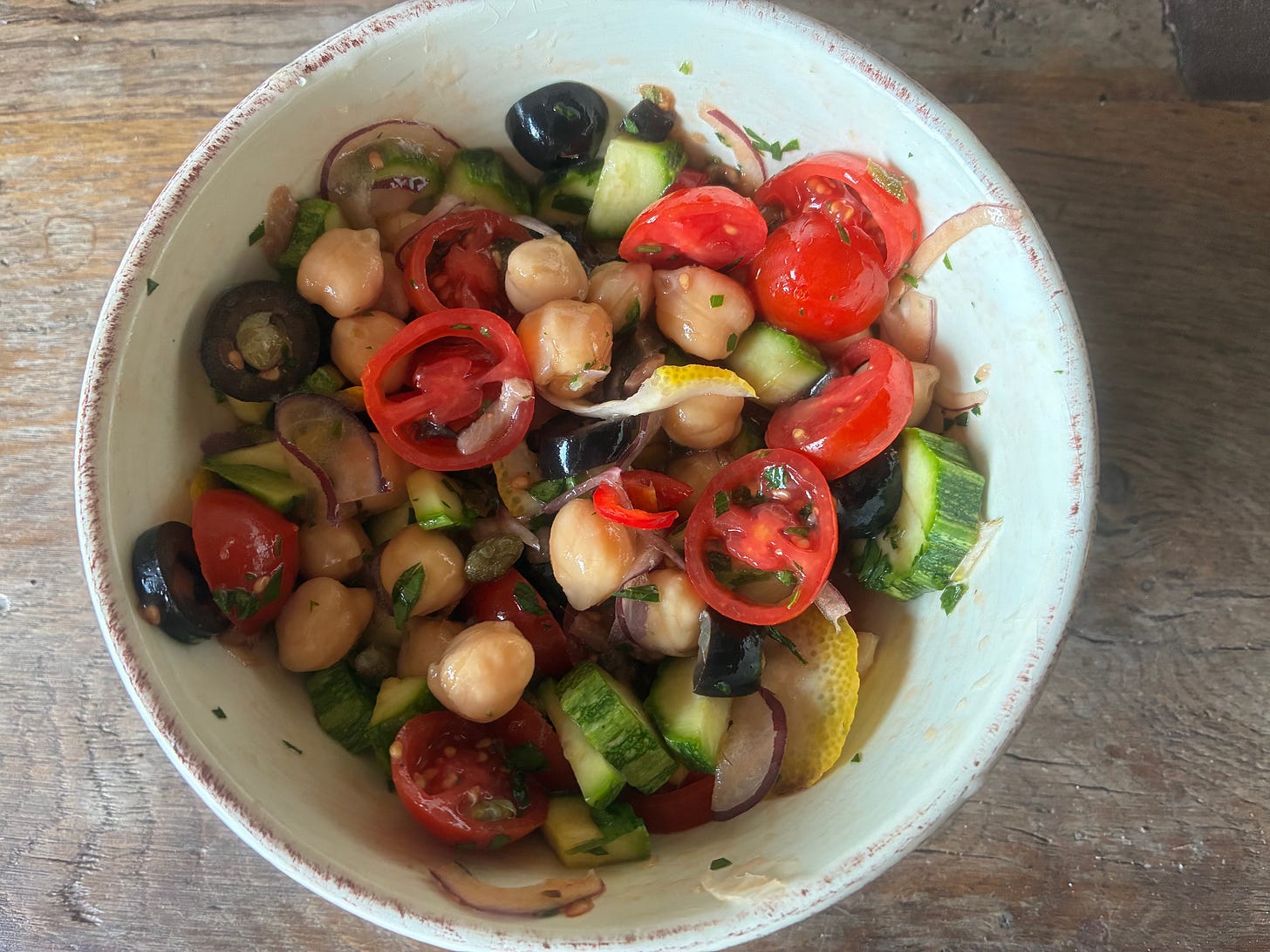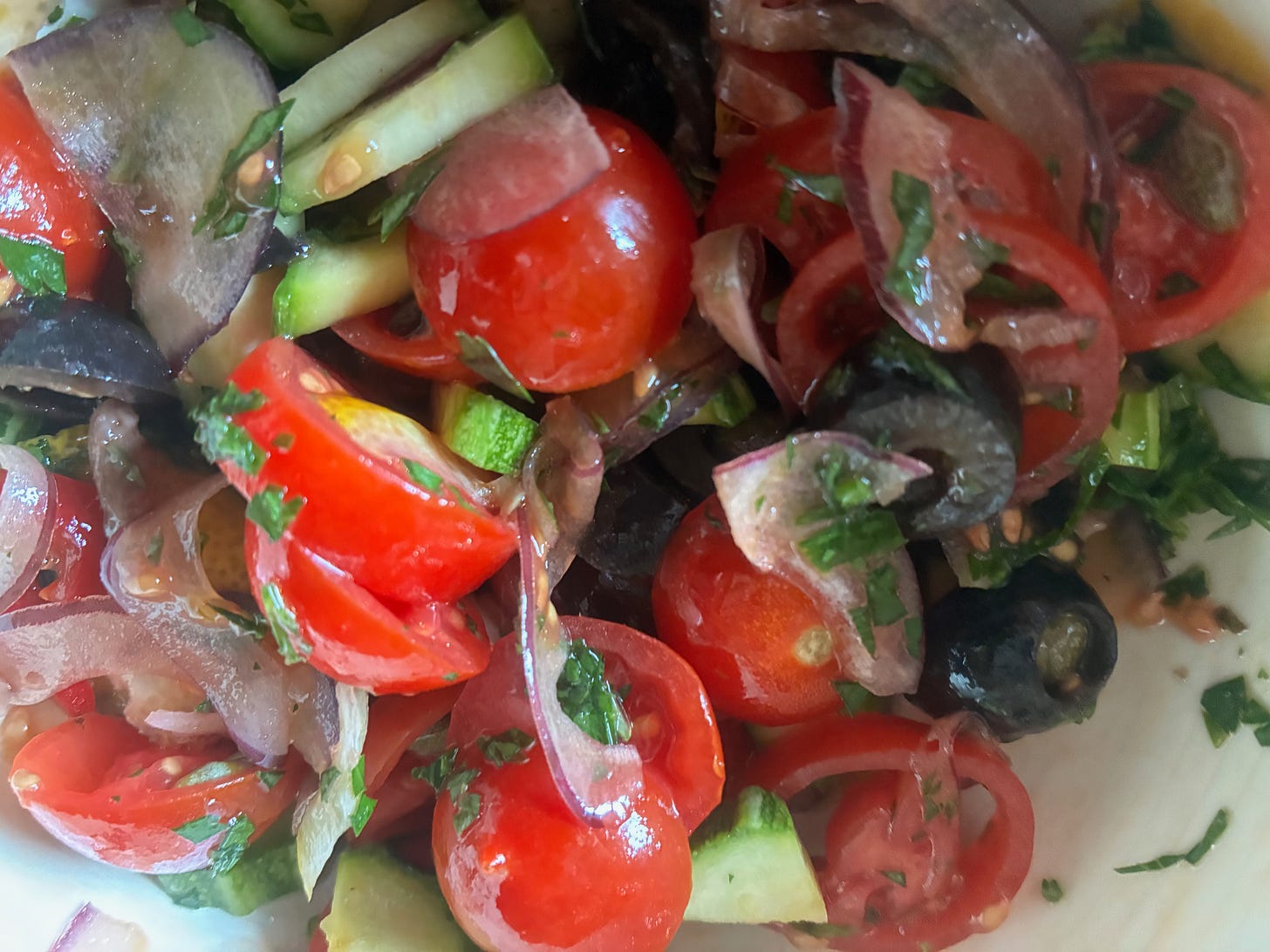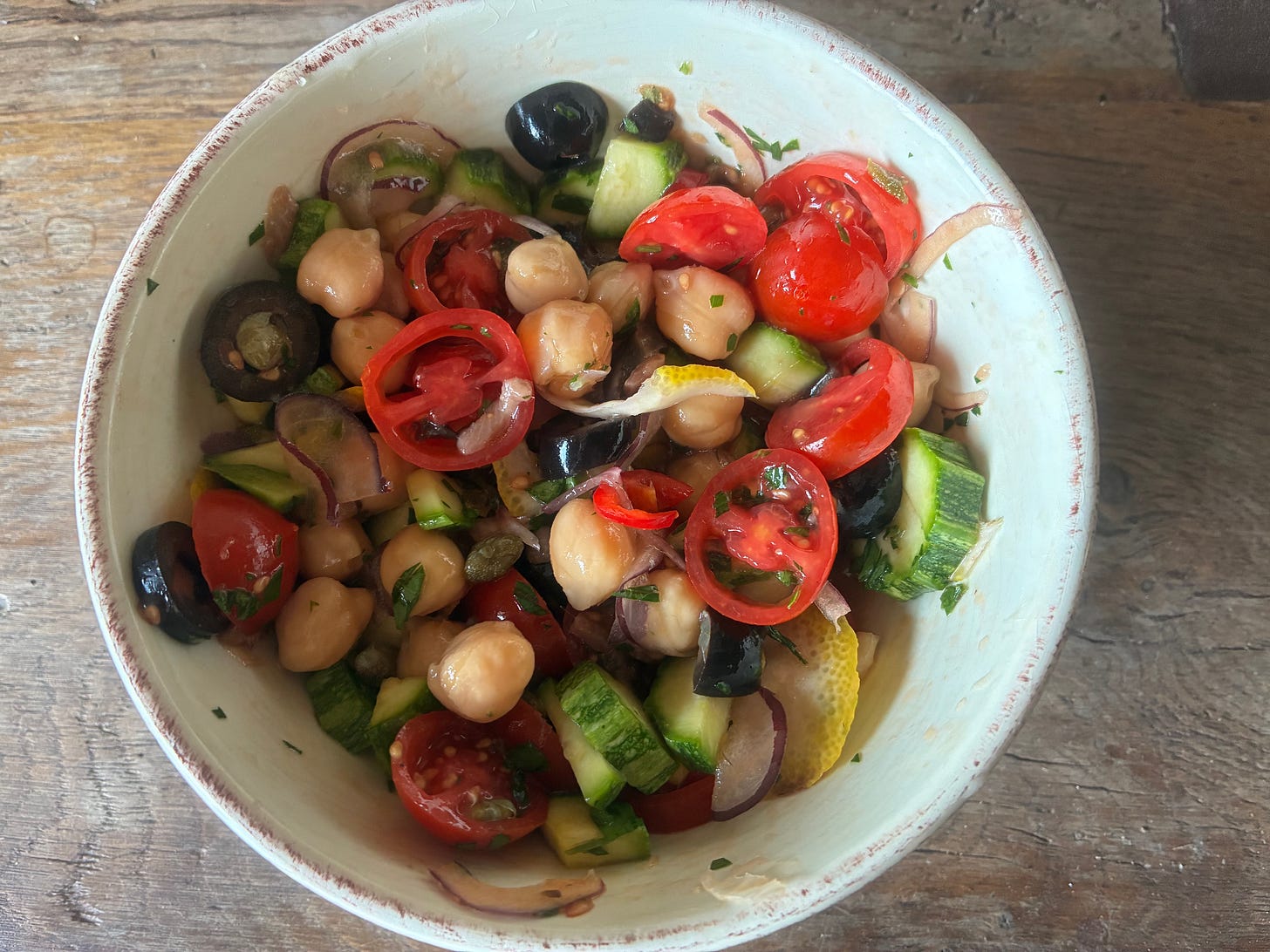Everyone has their own cooking eco-system
Sticking to it will make your life a lot easier and your food taste wonderful. Plus another consideration for your courgette and tomato glut: Tomato salad alla puttanesca.
When I was training at Leith’s, I once stood next to a girl making steamed syrup pudding. We were using the same recipe, the same ingredients, the same ovens, the same cake tins, and we beat our mixtures for exactly the same amount of time (by hand, and I still have the muscles to prove it*). Hers came out delectably light and golden. Mine did not. And I carried on being an indifferent cake-maker – apart from once, and in my final exam, when Prue Leith herself declared mine to be as delicious as it was beautiful. Am wondering if I should repeat that a few times. Perhaps have it beamed onto the facade of Buckingham Palace.
*I do not still have the muscles to prove it, but it’s World Self-Delusion Day and I am very keen to get involved.
It didn’t only happen with cake: I never made a dumpling that didn’t look like demented splurges left behind by a zombie apocalypse (my first term exam, in case you’re wondering). But there was nothing wrong with the recipe – it had been thoroughly tested and it worked for everyone else – and nothing wrong with me; I cook many things very well. We just didn’t get along. Somebody might one day do some research as to what exactly happens but until they do, treat you as a key ingredient in any recipe, and if you don’t taste good in it, cook something else.
Essentially, everyone has their own cooking eco-system – particular flavours and flavour combinations that work particularly well when they do them. And recipe architecture that enables their best cooking.
And by that I mean the way things are prepared – the size and shape ingredients are chopped or processed into – the amount of liquid, the flavourings, the length of cooking time, and cooking temperature. For instance, I always cook my omelettes at as high a heat as I can manage without setting off the smoke alarm, and they take about 30 seconds. I just read a recipe that suggested prep time was 5 minutes and cook time the same, and should be cooked at a medium-low temperature. Another suggested the secret was to blend rather than beat.
I whisk for as long as it takes to heat the pan up, throw it in, where it sizzles and throws itself about a bit; I push the edges in a couple of times , fold it in half and get it on a plate as fast as possible. From putting the pan on to get hot to putting the omelette on a plate takes no more than a minute, and it is absolutely the best omelette ever. But I have no doubt that the other ways work equally well for other people.
When I’m roasting a chicken, I fiddle around with the temperature – turning it up, then down, then up again; other people cook it at the same temperature all the way through. Some people can add liquid to the roasting dish and still get crispy skin; I cannot.
So when I create a new recipe, however marvellous I think it is, and however much I want everyone to try it out and do it exactly as I say, what I want even more is for people to enjoy cooking something delicious. And that might be from following my recipe to the last nanogram, or adapting it to something that works better for them, their tastebuds, and the contents of their fridge.
It’s a bit like what music you sing well, or the particular type of painting you’re good at. When you cook the things that you do well, life gets easier and the food gets better.
There is an exception to this cook-it-my-way rule
And that’s cooking with very little salt. It doesn’t work well for anybody — at least if you’re of the opinion that life is improved if it contains a great deal of delicious food. The jury is more out than you might think about the health benefits of a low salt diet, and imagine living an extra five years and having to eat tasteless food three times a day, every day; that’s 5,475 opportunities to feel that life is not worth living. And I didn’t even include the leap years.
Tomato salad alla puttanesca
I’ve just arrived in Italy, and for reasons not entirely clear, I’ve done my back in. So I haven’t yet stocked my fridge properly – which always brings out some really good food, and this time produced a puttanesca sauce in salad form, and it’s remarkably good. No idea why I’ve never done it before. To make it vegetarian and vegan, leave out the anchovy.
Serves 2
Two handfuls of cherry tomatoes
10 mild black olives
A quarter of a red onion
About a quarter of a lemon
2 Courgettes
One anchovy fillet
Half a red chilli
A very small handful of parsley
A few sprigs of thyme
A teaspoon of capers
2 – 4 teaspoons of olive oil
Salt and pepper
Roughly slice the tomatoes and the olives and put them in a bowl.
Very finely slice the onion and lemon. Use a mandolin unless you’re a violinist or brain surgeon.
Dice the courgettes.
Cut the anchovy into long, very thin strands.
Finely chop the chilli.
Chop the parsley and thyme.
Put everything except the anchovy in a bowl, mix well, season with salt and pepper, and mix well again.
Then add the anchovy and the olive oil and mix well again.
Diva Notes
Adding salt
Add the salt before the adding the anchovy to avoid salting the already salty anchovy.
Add chickpeas
If you want to make it more substantial, add a few chickpeas.







I am unfortunately coping with edema from cancer meds. Low sodium is non optional for me. As a person who in a past life would have agreed with you on the salt issue, no matter how much delicious basil and garlic and olive oil I add, it just is not the same. Also, I would kill for some olives 😆 thanks for the delicious thoughts of puttanesca. A girl can dream 💕
Another great article, Lizzie. I hope your back improves soon. 😊